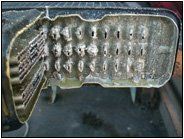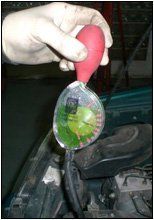COOLING SYSTEM
ABOUT THE COOLING SYSTEM
A vehicle’s cooling system is designed to dissipate the heat created by combustion and keep the engine running at an optimal temperature for good fuel economy. The heat is dissipated to the atmosphere through the radiator and to the passenger compartment through the heater when the heat is turned on. This is why if a vehicle starts to run too hot, turning on the heater will sometimes bring the temperature down.
The main components of the cooling system are the radiator, water pump, thermostat, cooling fan, heater core hoses and the coolant liquid.
Water Pump
The water pump is made up of an impeller which pushes the coolant liquid through the system. It is usually driven by the engine drive belt or timing belt via a pulley on the opposite end of the shaft from the impeller.
Thermostat
The thermostat is a heat activated valve which regulates the temperature of the coolant. It remains closed until the engine is warmed up, then opens and closes to keep the coolant within a narrow temperature range. If a thermostat remains open the temperature gauge will read low and the heater will produce very little heat.
Cooling Fan
A cooling fan is either a belt driven or electric fan. Its function is to move air through the radiator when the vehicle is stopped or moving slowly. Both types of fans are heat activated and only operate when the coolant reaches a certain temperature.
Heater
The heater is designed like a radiator and mounted in the passenger compartment. When the heater is turned on the fan pulls air through the heater and transports heat into the passenger compartment.
Hoses
Radiator and heater hoses connect the radiator and heater to the engine.


